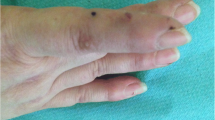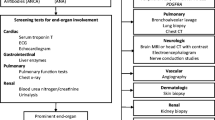Abstract
A 26-year-old man with idiopathic hypereosinophilic syndrome (HES) was treated with imatinib mesylate following a 5-year history of prednisolone therapy. The patient had hypereosinophilia (absolute eosinophil counts >1500/µL) occurring in cyclic oscillations as well as histologically diagnosed eosinophilic vasculitis, bursitis, and periodic soft-tissue swellings. Laboratory data revealed high levels of serum tryptase and increased numbers of mast cells in the bone marrow, but serum interleukin 5 levels were within the normal range. The disease initially responded well to 100 mg/day of imatinib mesylate but recurred 8 weeks later. Thereafter, a daily 200-mg dose was temporarily effective. Despite the response to imatinib, the FIP1L1-PDGFRA fusion gene was not detected by fluorescence in situ hybridization analysis. Additional molecular and cytogenetic studies showed neither translocations of platelet-derived growth factor receptor (PDGFR) genes nor mutations in the c-KIT or the PDGFR genes. Although imatinib mesylate is a choice of treatment for patients with HES, its precise molecular mechanism in individual cases remains to be clarified.
Similar content being viewed by others
References
Gleich GJ, Leiferman KM, Pardanani A, Tefferi A, Butterfield JH. Treatment of hypereosinophilic syndrome with imatinib mesilate. Lancet. 2002;359:1577–1578.
Cools J, DeAngelo DJ, Gotlib J, et al. A tyrosine kinase created by fusion of the PDGFRA and FIP1L1 genes as a therapeutic target of imatinib in idiopathic hypereosinophilic syndrome. N Engl J Med. 2003;348:1201–1214.
Pardanani A, Reeder T, Porrata LF, et al. Imatinib therapy for hypereosinophilic syndrome and other eosinophilic disorders. Blood. 2003;101:3391–3397.
Cortes J, Ault P, Koller C, et al. Efficacy of imatinib mesylate in the treatment of idiopathic hypereosinophilic syndrome. Blood. 2003;101:4714–4716.
Klion AD, Noel P, Akin C, et al. Elevated serum tryptase levels identify a subset of patients with a myeloproliferative variant of idiopathic hypereosinophilic syndrome associated with tissue fibrosis, poor prognosis, and imatinib responsiveness. Blood. 2003;101:4660–4666.
Wilkinson K, Velloso ER, Lopes LF, et al. Cloning of the t(1;5) (q23;q33) in a myeloproliferative disorder associated with eosinophilia: involvement of PDGFRB and response to imatinib. Blood. 2003;102:4187–4190.
Pardanani A, Ketterling RP, Brockman SR, et al. CHIC2 deletion, a surrogate for FIP1L1-PDGFRA fusion, occurs in systemic mastocytosis associated with eosinophilia and predicts response to imatinib mesylate therapy. Blood. 2003;102;3093–3096.
Noth I, Strek ME, Leff AR. Churg-Strauss syndrome. Lancet. 2003;361:587–594.
Moor JW, U-King Im J, MacDonald AW, Whitehead E. Limited form of Churg-Strauss syndrome presenting as a mass in the neck. J Laryngol Otol. 2002;116:966–968.
Leon-Ruiz L, Jimenez-Alonso J, Hidalgo-Tenorio C, et al. Churg- Strauss syndrome complicated by endomyocardial fibrosis and intraventricular thrombus: importance of the echocardiography for the diagnosis of asymptomatic phases of potentially severe cardiac complications. Lupus. 2002;11:765–767.
Val-Bernal JF, Mayorga M, Garcia-Alberdi E, Pozueta JA. Churg-Strauss syndrome and sudden cardiac death. Cardiovasc Pathol. 2003;12:94–97.
Hirota S, Ohashi A, Nishida T, et al. Gain-of-function mutations of platelet-derived growth factor receptor α gene in gastrointestinal stromal tumors. Gastroenterology. 2003;125:660–667.
Heinrich MC, Corless CL, Duensing A, et al. PDGFRA activating mutations in gastrointestinal stromal tumors. Science. 2003;299:708–710.
Bain BJ. Cytogenetic and molecular genetic aspects of eosinophilic leukaemias. Br J Haematol. 2003;122:173–179.
Frickhofen N, Marker-Hermann E, Reiter A, et al. Complete molecular remission of chronic eosinophilic leukemia complicated by CNS disease after targeted therapy with imatinib. Ann Hematol. 2004;83:477–480.
Pardanani A, Brockman SR, Patermoster SF, et al. FIP1L1- PDGFRA fusion: prevalence and clinicopathologic correlates in 89 consecutive patients with moderate to severe eosinophilia. Blood. 2004;104:3038–3045.
Wolf D, Gastl G, Rumpold H. Complete remission of an idiopathic hypereosinophilic syndrome while using imatinib [in German]. Dtsch Med Wochenschr. 2004;129:2104–2106.
Musto P, Falcone A, Sanpaolo G, et al. Heterogeneity of response to imatinib-mesylate (Glivec) in patients with hypereosinophilic syndrome: implications for dosing and pathogenesis. Leuk Lymphoma. 2004;45:1219–1222.
Tan D, Hwang W, Ng HJ, Goh YT, Tan P. Successful treatment of idiopathic hypereosinophilic syndrome with imatinib mesylate: a case report. Int J Hematol. 2004;80:75–77.
Xiao Z, Hao Y, Qin T, Han Z. Periodic oscillation of blood leukocytes, platelets, and hemoglobin in a patient with chronic eosinophilic leukemia. Leuk Res. 2003;27:89–91.
Malcovati L, La Starza R, Merante S, Pietra D, Mecucci C, Cazzola M. Hypereosinophilic syndrome and cyclic oscillations in blood cell counts: a clonal disorder of hematopoiesis originating in a pluripotent stem cell. Haematologica. 2004;89:497–499.
Pottier P, Planchon B, Grossi O. Complete remission with imatinib mesylate (Glivec) of an idiopathic hypereosinophilic syndrome associated with a cutaneous mastocytosis after failure of interferon- alpha [in French]. Rev Med Interne. 2003;24:542–546.
Author information
Authors and Affiliations
About this article
Cite this article
Imashuku, S., Kakazu, N., Ueda, I. et al. Response to Imatinib Mesylate in a Patient with Idiopathic Hypereosinophilic Syndrome Associated with Cyclic Eosinophil Oscillations. Int J Hematol 81, 310–314 (2005). https://doi.org/10.1532/IJH97.04185
Received:
Revised:
Accepted:
Published:
Issue Date:
DOI: https://doi.org/10.1532/IJH97.04185




